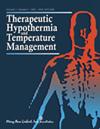Progress of Brain Hypothermia Treatment for Severe Subarachnoid Hemorrhage-177 Cases Experienced and a Narrative Review.
IF 0.8
4区 医学
Q4 CRITICAL CARE MEDICINE
引用次数: 0
Abstract
The benefits of hypothermia for the treatment of subarachnoid hemorrhage (SAH) remain controversial. In 1999, we initiated brain hypothermia treatment (BHT) in the hyperacute phase to mitigate the evolution of early brain injury in patients with World Federation of Neurological Surgeons (WFNS) grade V SAH. In June 2014, we introduced endovascular cooling to maintain normothermia for seven days following the initial BHT period. Immediately after the decision to treat the sources of bleeding, cooling was initiated, with a target temperature of 33-34°C. Bleeding sources were extirpated primarily by clipping with decompressive craniectomy. Patients were rewarmed at a rate of ≤1°C/day after ≥48 hours of surface cooling. After being rewarmed to 36°C, temperatures were controlled with antipyretic (chronologically divided into groups A-C with 47, 46, and 46 patients, respectively) or endovascular (group D, 38 patients) cooling. Overall, 177 patients (median age, 62 [52-68] years; 94 [53.1%] women; onset-to-arrival time, 36 minutes [28-50]) were included. The median Glasgow Coma Scale (GCS) score upon admission was 4 (3-6). Median core body temperature was 36 (35.3-36.6)°C on arrival, 34.6 (34.0-35.3)°C on entering the operating room, 33.8 (33.4-34.3)°C upon starting the microsurgical or interventional radiology procedure, and 33.7 (33.3-34.2)°C upon admission to the intensive care unit. There were no significant differences in age, sex, GCS score, pupillary findings, location of bleeding sources, or treatment methods. There were 69 (39.0%) overall favorable outcomes (modified Rankin Scale score of 0-3) at 6 months and 11 (23.4%), 18 (39.1%), 17 (37.0%), and 23 (60.5%) in groups A-D, respectively (p = 0.0065). The outcomes of patients with WFNS grade V SAH improved over time. Herein, we report our experience using BHT for severe SAH through a narrative review.严重蛛网膜下腔出血的脑低温治疗进展--177 例经验和叙事回顾。
低体温治疗蛛网膜下腔出血(SAH)的益处仍存在争议。1999年,我们在超急性期启动了脑低温治疗(BHT),以缓解世界神经外科医师联合会(WFNS)V级SAH患者早期脑损伤的演变。2014年6月,我们引入了血管内降温,在最初的BHT期后维持7天的正常体温。在决定治疗出血源后,我们立即开始降温,目标温度为33-34°C。主要通过减压开颅手术剪除出血源。患者在体表降温≥48小时后,以每天≤1°C的速度复温。复温至 36°C 后,使用退烧药(按时间顺序分为 A-C 组,分别有 47、46 和 46 名患者)或血管内冷却(D 组,38 名患者)控制体温。总共有 177 名患者(中位年龄 62 [52-68] 岁;女性 94 [53.1%];发病到到达时间 36 分钟 [28-50])被纳入其中。入院时格拉斯哥昏迷量表(GCS)的中位数为 4(3-6)分。到达时的核心体温中位数为 36 (35.3-36.6)°C,进入手术室时的核心体温中位数为 34.6 (34.0-35.3)°C,开始显微外科或介入放射手术时的核心体温中位数为 33.8 (33.4-34.3)°C,进入重症监护室时的核心体温中位数为 33.7 (33.3-34.2)°C。年龄、性别、GCS 评分、瞳孔检查结果、出血源位置或治疗方法均无明显差异。6 个月时,69 例(39.0%)患者总体预后良好(改良兰金量表评分 0-3 分),A-D 组分别为 11 例(23.4%)、18 例(39.1%)、17 例(37.0%)和 23 例(60.5%)(P = 0.0065)。随着时间的推移,WFNS V 级 SAH 患者的预后有所改善。在此,我们通过叙述性回顾报告了使用 BHT 治疗严重 SAH 的经验。
本文章由计算机程序翻译,如有差异,请以英文原文为准。
求助全文
约1分钟内获得全文
求助全文
来源期刊

Therapeutic hypothermia and temperature management
CRITICAL CARE MEDICINE-
CiteScore
2.50
自引率
8.30%
发文量
35
期刊介绍:
Therapeutic Hypothermia and Temperature Management is the first and only journal to cover all aspects of hypothermia and temperature considerations relevant to this exciting field, including its application in cardiac arrest, spinal cord and traumatic brain injury, stroke, burns, and much more. The Journal provides a strong multidisciplinary forum to ensure that research advances are well disseminated, and that therapeutic hypothermia is well understood and used effectively to enhance patient outcomes. Novel findings from translational preclinical investigations as well as clinical studies and trials are featured in original articles, state-of-the-art review articles, protocols and best practices.
Therapeutic Hypothermia and Temperature Management coverage includes:
Temperature mechanisms and cooling strategies
Protocols, risk factors, and drug interventions
Intraoperative considerations
Post-resuscitation cooling
ICU management.
 求助内容:
求助内容: 应助结果提醒方式:
应助结果提醒方式:


